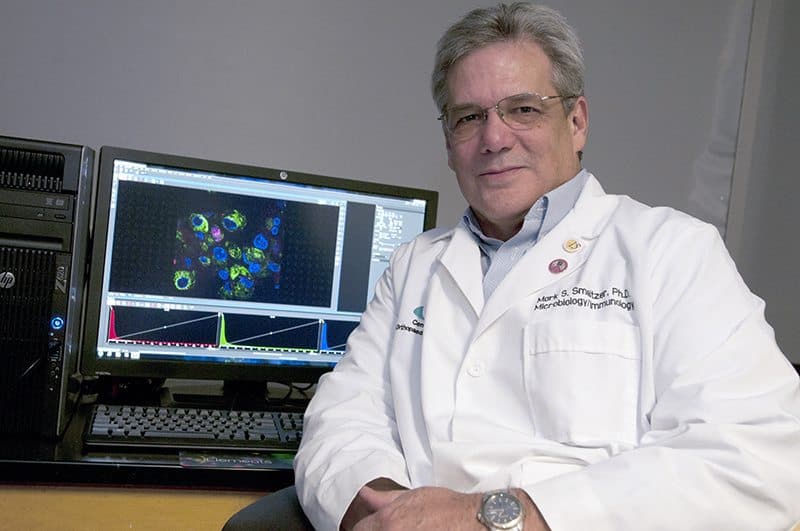Researchers Combat Antibiotic-Resistant Infections With Nanodrug
| LITTLE ROCK – A research team led by University of Arkansas for Medical Sciences (UAMS) microbiologist Mark Smeltzer, Ph.D., and University of Arkansas chemist Jingyi Chen, Ph.D., has developed an alternative therapeutic approach to fighting antibiotic-resistant infections.
The novel method uses a targeted nanodrug consisting of gold nano “cages” loaded with antibiotic that when irradiated with lasers, converts the irradiation to heat which generates a “photothermal effect” capable of killing bacteria and at the same time releases the antibiotic, thus resulting in a synergistic therapeutic effect. Nanoparticles are extremely tiny materials, containing just a few atoms.
This work was recently published in ACS Infectious Diseases, a publication of the American Chemical Society (ACS).
“We believe that this approach could facilitate the effective treatment of infections caused by antibiotic-resistant bacteria including those associated with bacterial biofilms, which are involved in a wide variety of bacterial infections,” said Chen, assistant professor in the Department of Chemistry and Biochemistry in the J. William Fulbright College of Arts and Sciences.
Microbial resistance to antibiotics has become a growing public health concern in hospitals and the community at large. The Infectious Diseases Society of America has designated six bacterial species as “ESKAPE pathogens” – Enterococcus faecium, Staphylococcus aureus, Klebsiella pneumoniae, Acinetobacter baumannii, Pseudomonas aeruginosa and Enterobacter species– owing to decreasing availability of antibiotics that are active against these species.
“It is also estimated that 80 percent of all bacterial infections involve formation of a biofilm, and all of these infections share the common characteristic of intrinsic resistance to all antibiotic therapy, ” said Smeltzer, professor in the Department of Microbiology and Immunology at UAMS and director of the Center for Microbial Pathogenesis and Host Inflammatory Responses.
Researchers in Smeltzer’s laboratory study Staphylococcus aureus, one of the six ESKAPE pathogens. They focus on how the pathogen causes biofilm-associated bone infection and infections associated with orthopaedic implants. Smeltzer noted there are many other examples of infections caused by Staphylococcus aureus – intravenous catheters and vascular grafts, for example.
The team used Staphylococcus aureus to demonstrate the potency of their nanodrug. The combination of achieving a photothermal effect and controlled release of antibiotics directly at the site of infection was achieved by laser irradiation at levels within the current safety standard for use in humans.
The synergistic therapeutic effects of this approach were validated using planktonic bacterial cultures, which are bacterial cells that are free-floating rather than contained with a biofilm, of both methicillin-sensitive and methicillin-resistant Staphylococcus aureus (MRSA) strains. However, the method was subsequently shown to be effective even in the context of an intrinsically resistant biofilm.
Additionally, Smeltzer said, “The even better news is that the technology we developed would be readily adaptable to other bacterial pathogens that cause such infections, including the other ESKAPE pathogens.”
Participating in the research were first authors Daniel Meeker, an M.D./Ph.D. student in Smeltzer’s lab, and Samir Jenkins, Ph.D., a postdoctoral fellow at U of A, as well as author Karen Beenken, Ph.D., a postdoctoral fellow at UAMS.
About the University of Arkansas: The University of Arkansas provides an internationally competitive education for undergraduate and graduate students in more than 200 academic programs. The university contributes new knowledge, economic development, basic and applied research, and creative activity while also providing service to academic and professional disciplines. The Carnegie Foundation classifies the University of Arkansas among only 2 percent of universities in America that have the highest level of research activity. U.S. News & World Report ranks the University of Arkansas among its top American public research universities. Founded in 1871, the University of Arkansas comprises 10 colleges and schools and maintains a low student-to-faculty ratio that promotes personal attention and close mentoring.
About the University of Arkansas for Medical Sciences: UAMS is the state’s only comprehensive academic health center, with colleges of Medicine, Nursing, Pharmacy, Health Professions and Public Health; a graduate school; a hospital; a northwest Arkansas regional campus; a statewide network of regional centers; and seven institutes: the Winthrop P. Rockefeller Cancer Institute, the Jackson T. Stephens Spine & Neurosciences Institute, the Myeloma Institute, the Harvey & Bernice Jones Eye Institute, the Psychiatric Research Institute, the Donald W. Reynolds Institute on Aging and the Translational Research Institute. It is the only adult Level 1 trauma center in the state. UAMS has 3,021 students, 789 medical residents and two dental residents. It is the state’s largest public employer with more than 10,000 employees, including about 1,000 physicians and other professionals who provide care to patients at UAMS, Arkansas Children’s Hospital, the VA Medical Center and UAMS regional centers throughout the state. Visit www.uams.edu or www.uamshealth.com. Find us on Facebook, Twitter, YouTube or Instagram.
